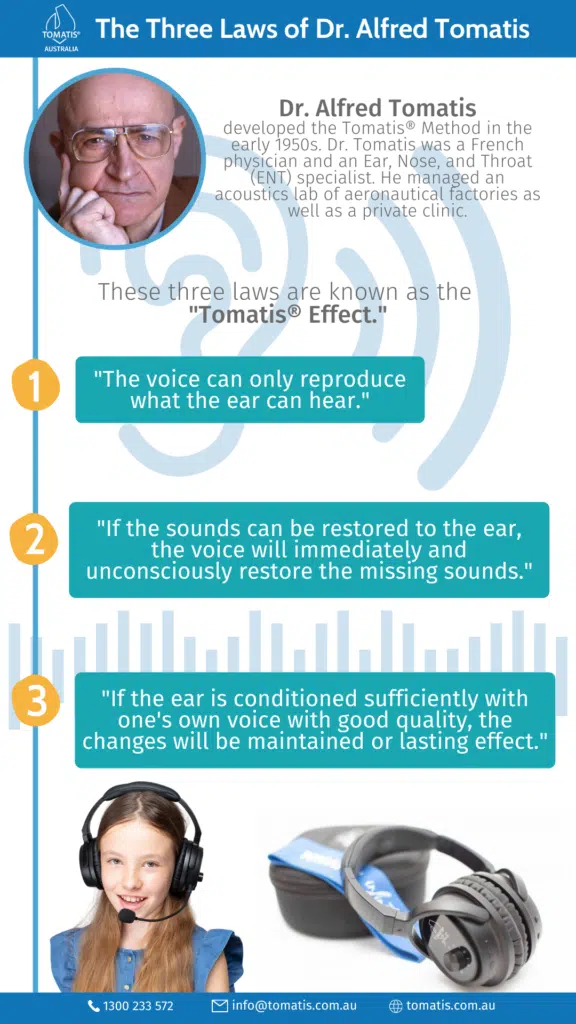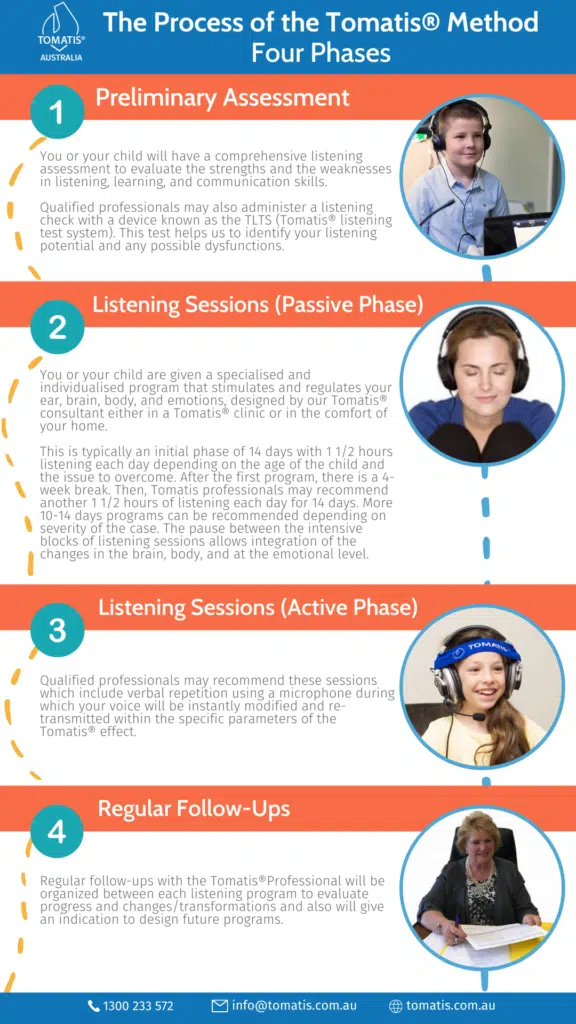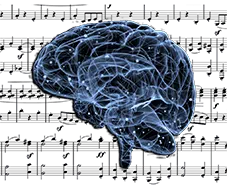What is the Tomatis® Method?
Children, teens, and adults may suffer from various difficulties linked to auditory system disorders.
The core specialty of the Tomatis® Method is to retrain the auditory processing, balance, and coordination or connections between the ear, brain, and body.
The Tomatis® Method, a neurosensory program and educational intervention, uses mainly music (by Mozart and some other composers) played over a special headphone and player. The modified or filtered music stimulates parts of the ear responsible for transmitting information to the brain.
The auditory stimulation retrains the brain and re-patterns the nervous system, which leads to improvement in physical, cognitive, and interpersonal skills and emotional regulation.
What are the benefits of the Tomatis® Method?
The ear, a “sensory gate,” serves as an access to the brain to create change. The Tomatis® Method generally:
- Improves attention, concentration, focus, and memory
- Develops language, speech, communication and socialisation
- Enhances learning skills like reading and comprehension
- Boosts self-awareness and confidence
- Reduces anxiety and stress
- Promotes better quality of life (sleep, appetite)
What are sound and music therapies?
- Sound healing directs specific sounds creating vibrations that impact a person’s well-being. The “Mozart Effect” is one of the most famous sound therapies. A study suggests listening to Mozart’s music for 10 minutes enhances a person’s spatial-temporal reasoning performance. Some claim that other than cognitive performance, it influences emotions, too.
- Music healing uses music to communicate for people who have difficulty expressing their feelings and thoughts in words. It is a way of eliciting engagement or active participation of a person by creating music, which leads to positive health results.
- Sound training promotes music as stimulation to identify and create frequencies specific to the listener. Sound and listening training is based on the work developed by Dr. Tomatis.
Who invented the Tomatis® Method?
Dr. Alfred Tomatis developed the Tomatis® Method in the early 1950s. Dr. Tomatis was a French physician and an Ear, Nose, and Throat (ENT) specialist. He managed an acoustics lab of aeronautical factories as well as a private clinic.
His musical upbringing and profession served as building blocks in developing the Tomatis® Method. He observed vocal deficiencies among factory workers who have work-related deafness. He treated and tested professional singers who presented symptoms similar to the factory workers. Through these cases, Dr. Tomatis theorised that “The voice only produces what the ear hears and the brain processes.”

What is the basis of the Tomatis® Method?
The “Tomatis® Effect” established the link between ear and voice. It explained the ear’s role in listening and communication. Hearing is said to be passive as the ear receives sounds. However, Dr. Tomatis believed that a person can hear but may not give meaning to the sound.
It can be due to middle and inner ear problems, which can be corrected by listening to modified music. This process stimulates the ears and their connections to the brain. As a result, it improves listening skills, communication, attention, and more.
Dr. Tomatis’s understanding of this concept enabled him to invent the “electronic ear.” The electronic sound system facilitated the re-education and restoration of singers’ impaired voice qualities. He presented this creation, which won him the Prize of Innovation at the Brussels World Exhibition in 1958.
What is electronic Gating®?
The Tomatis® Method uses an innovative form of neurosensory stimulation training to retrain the functions of the brain. Gating® is the core of the Tomatis® Method. It is when sound contrast is produced between frequencies that activate the brain’s attention mechanism. It forces the brain to cope with the information changes it receives from the auditory system. Gating® is waking up the brain from its usual pattern and makes it actively listen.
How does Gating® work?
The Tomatis® Method uses an electronic ear with special filters which divide sound into two channels, namely C1 and C2.
The C1 channel delivers low frequencies as a calming and soothing timbre that relaxes the auditory system momentarily. The C2 channel delivers high frequencies with a brighter and sharper timbre. It stimulates the brain’s attention mechanism needed to process sounds precisely.
“The Gating®” is the back-and-forth switching between C1 and C2 channels. The sound intensity and timbre change creates a contrast that exercises the connection between the ear and brain.
What is the special listening device or electronic ear?
Dr. Tomatis promoted right ear dominance. The right ear connects to the left side of the brain, responsible for comprehension, logical reasoning, and oral language. In reverse, the left ear connects to the right side of the brain, which plays a role in emotional perception and musicality. Impaired auditory processing causes behavioural, language, learning, and speech difficulties. Examples are dyslexia, ADHD, autism, APD and more.
Dr. Tomatis realised that training the right ear to detect and discriminate changes in sound may improve personal and social well-being.
A special hearing device is used to train the ear. An example of an electronic ear is the TalksUp® player that makes “the Gating” possible. The sound contrast passes through the high-quality headphones made for air and bone conduction.
Air conduction happens when the ear receives a sound through the air entering the canal. Bone conduction occurs when the ear’s bone structure picks up sound vibrations. The TalksUp® delivers the sound through specific headphones using air conduction and works as a vibrator for bone conduction.
How does bone conduction work?
Sounds through bone travel faster than through the air canal. In effect, you hear your words better through bone than air conduction when you speak. The Tomatis® Method with the use of the headphone plays music.
The music is sensed first by the bone and transmits it to the brain. The brain then anticipates the incoming sound as it travels through the air canal. This mechanism gets the brain to pay attention to the sound or the music.
The TalksUp® can adjust the settings of the headphone to maximise bone conduction. It has a switch for bone and air conduction with adjustable time delays. It is known as Delay and Precession.
Delay (Delay 1) refers to the time needed for bone conduction to move from C1 to C2 (Gating). Precession (Delay 2) refers to the time required for air conduction to go from C1 to C2 after the bone conduction signal is switched to C2.
There is a delay of sound in a natural setting as it travels faster in bone than air conduction. The Tomatis® Method increases the delay through the Precession mechanism to give a longer time for the untrained ear to get ready to listen. The time delays can be adjusted as the ear learns to listen faster.
What do we mean that sound and listening start in the womb?
Dr. Tomatis was a forerunner in the field of prenatal care. He believed that babies start to listen even before they are even born through bone conduction. Inside their mother’s womb, babies can hear what the mother says from about 18 weeks in the pregnancy. Their listening can be affected by external conditions during pregnancy. It includes the mother’s emotional and physical well-being, such as stress and trauma.
The Tomatis® Method offers an opportunity for a child to revisit the time in the mother’s womb. A child listens to the mother’s voice which is filtered to produce the best results. This auditory sensory stimulation positively impacts the brain development of the child.
What does the Tomatis® Method improve?
The Tomatis® Method helps people of all ages with:
- Sensory functions
- Auditory processing disorders
- Sensory integration issues
- Global Development Disorders
- Cognitive and developmental functions
- Language problems
- Learning difficulties
- Communication difficulties
- Speech and language development delays
- Emotional functions
- Behavioural issues linked to ADHD and Autism Spectrum Disorder
- Depression, anxiety, stress, and more
- Emotional disorders

Tomatis® Listening Program (auditory stimulation)
Listening to music, mainly Mozart and Gregorian Chant, through TalksUp® and a special headset including bone and air conduction applies the “Tomatis® effect” with the Gating® that re-educates the ear and the brain and awakens your listening skills!
How Does The Tomatis® Method Work?

Someone may hear well but listen poorly
Hearing is an involuntary ability of the ear whilst listening is an active, voluntary skill of the brain to understand the meaning of sounds through the ear. However, barriers ranging from background noise to deep-seated learning and auditory processing difficulties associated with emotional overload become challenges for you or your child.

Established on neuroplasticity by stimulating the brain
Some people cannot “process” information even when they are hearing it; hence, they have difficulties in listening. So, the Tomatis® Method helps in rewiring these processing connections in the brain via the ear for better learning, communication, and emotional balance. The way it does it is by creating unpredictable musical contrasts which surprise the brain and trigger the attentional mechanisms.
The Tomatis® Method is a pedagogical method used to improve the listening of a person whose hearing functions correctly. It works thanks to a device that causes musical contrasts by suddenly and unpredictably changing the timbre and intensity of the music. This effect will surprise the brain and trigger its attentional mechanisms. We say that the brain puts itself into a listening position.
Sound is transmitted through air via the ear canal. It is also transmitted by vibration at the top of the headset. This vibration is called bone conduction. Bone conduction transmits the sound directly to the inner ear; thus, preparing it to receive the sound transmitted through the ear drum.
The switch to Channel 2 causes the muscles of the ear to tense. Conversely, the switch back to Channel 1 lets these muscles to relax. Thus, the muscles of the ear are subjected to a gymnastic exercise.
In this way, the stirrup muscle tenses and relaxes thanks to the Tomatis effect improving the regulation of the inner ear and playing a role of preparation. More generally, it is the entire auditory system that is stimulated by a sudden change of timbre and intensity.
The vestibule and the cochlea have a fundamental role of providing energy to the brain. In the cochlea, high frequency sounds stimulate the brain much more than low frequency sounds. Channel 2 will strongly activate the lower part of this cochlear duct and thus, favour the reception of high frequencies and their transmission to the brain.
This transmission takes place through the transformation of the acoustic vibration that is perceived into electrical stimulation. The electrical message is transmitted to the auditory cortex and the peripheral cortical areas that are directly connected to the pre-frontal cortex. The latter integrates and analyses the information received.
In return, this integrated information is directed back to the ear favoring not only the perception of the acoustic information and the ability to focus on it but also the improvement of motor programs concerning fine and gross motor functions.
Thus, through this back-and-forth between the brain and the receptors in the inner ear, we can see it in reality that the ear is a sensory-motor organ that plays a decisive role in our personal development. That is why the Tomatis® Method acts in a natural, non-intrusive manner on the auditory system and the brain. This leads to improvements in learning, attention, communication, reading, listening, [and] sensory processing.
The Tomatis® Method is definitely the best gift for you or your child! Contact Françoise Nicoloff or any of our Tomatis® professionals in Australia to get started today!


